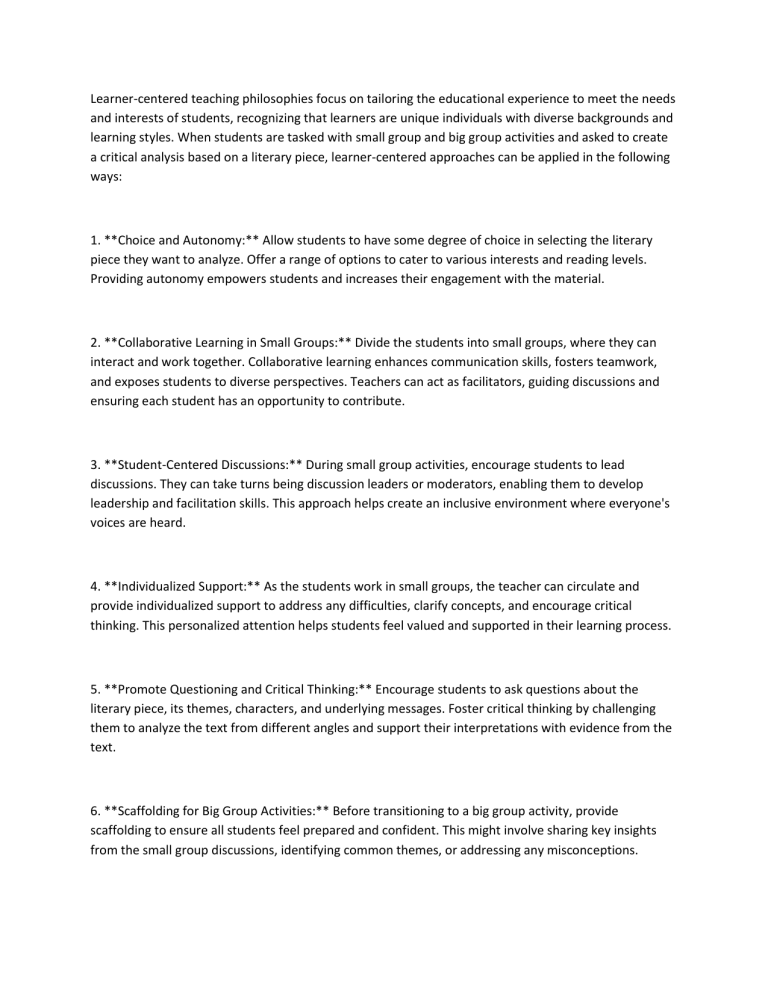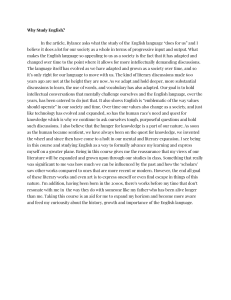
Learner-centered teaching philosophies focus on tailoring the educational experience to meet the needs and interests of students, recognizing that learners are unique individuals with diverse backgrounds and learning styles. When students are tasked with small group and big group activities and asked to create a critical analysis based on a literary piece, learner-centered approaches can be applied in the following ways: 1. **Choice and Autonomy:** Allow students to have some degree of choice in selecting the literary piece they want to analyze. Offer a range of options to cater to various interests and reading levels. Providing autonomy empowers students and increases their engagement with the material. 2. **Collaborative Learning in Small Groups:** Divide the students into small groups, where they can interact and work together. Collaborative learning enhances communication skills, fosters teamwork, and exposes students to diverse perspectives. Teachers can act as facilitators, guiding discussions and ensuring each student has an opportunity to contribute. 3. **Student-Centered Discussions:** During small group activities, encourage students to lead discussions. They can take turns being discussion leaders or moderators, enabling them to develop leadership and facilitation skills. This approach helps create an inclusive environment where everyone's voices are heard. 4. **Individualized Support:** As the students work in small groups, the teacher can circulate and provide individualized support to address any difficulties, clarify concepts, and encourage critical thinking. This personalized attention helps students feel valued and supported in their learning process. 5. **Promote Questioning and Critical Thinking:** Encourage students to ask questions about the literary piece, its themes, characters, and underlying messages. Foster critical thinking by challenging them to analyze the text from different angles and support their interpretations with evidence from the text. 6. **Scaffolding for Big Group Activities:** Before transitioning to a big group activity, provide scaffolding to ensure all students feel prepared and confident. This might involve sharing key insights from the small group discussions, identifying common themes, or addressing any misconceptions. 7. **Inclusive Big Group Discussions:** In the big group setting, facilitate discussions that are inclusive and respectful. Encourage quieter students to participate and ensure that all contributions are acknowledged and valued. Use strategies like think-pair-share to promote active engagement. 8. **Respect for Diverse Perspectives:** When analyzing a literary piece, acknowledge and respect the diversity of perspectives that students may bring based on their background, culture, and experiences. Create a safe space for students to share their viewpoints without fear of judgment. 9. **Feedback and Reflection:** Throughout the process, provide constructive feedback on the students' critical analysis. Encourage self-reflection, where students assess their own strengths and areas for improvement in their analysis and group collaboration. 10. **Celebration of Creativity:** Allow students to express their critical analysis creatively, such as through presentations, multimedia projects, or artistic interpretations. Emphasize that there can be multiple valid approaches to analyzing literature. By applying learner-centered teaching philosophies in these ways, educators can foster a positive and supportive learning environment, promoting students' critical thinking skills, collaborative abilities, and overall engagement with the literary piece.





